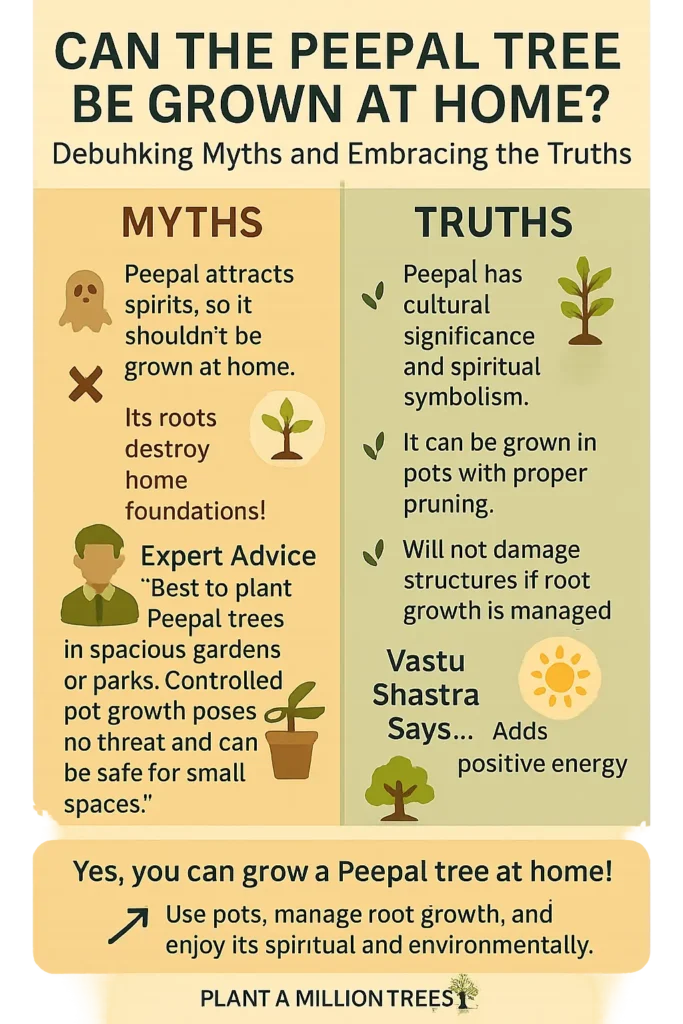India is also in a run-against-time in balancing the urbanization, air pollution and outcome of climate change. With urban...
The Peepal tree (Ficus religiosa), often sidelined in the gregarious noise of urbanization, stands out as one of the most sacred trees that are also scientifically respected and environmentally valued in India. Renowned as the “Tree of Enlightenment,” it has been a witness to all through centuries of history, tradition, healing, and scientific curiosity.
The significance of the Peepal tree is even beyond cultural and spiritual beliefs and phenomenal ecological benefits that make it a superhero in the natural world.
For being revered as a tree of public worship from temple courtyards, finding mention in the Vedic scriptures, and now in scientific journals, the Peepal tree has very symphonically married science with spirituality in its leafy embrace.
The Significance of the Peepal Tree in Indian Culture

Why the Peepal Tree Holds a Special Place in Indian Tradition
An inseparable part of Indian custom and traditions, flora occupies a huge place in the rituals through the ages. Among all plants talked about in ancient texts and sung about in folklore, Peepal stands highly on a sacred pedestal.
These texts of Hinduism, Buddhism, and Jainism have termed it a dwelling place for the gods, a seat of meditation for the saints, and all other such things.
Under this tree, Lord Buddha was said to have attained enlightenment; hence the tree has come to symbolize wisdom or spiritual awakening.
The Vedic canonical texts mention this tree as the cosmic axis linking heaven and earth-great bridge between the material and divine realm.
The Peepal is a whole culture that is celebrated in several ways with countless rituals that bind people together within the village.
Spiritual & Religious Importance of the Peepal Tree
Sacred Symbolism: The Peepal Tree in Religion
Hindus worship the Peepal tree for their lamp, with thread and offering among the throngs across India, and have therefore become deeply folded into the religious psyche of the country.
It is known to women for associating the tree with Lord Vishnu, and praying to it for their family well-being. For Jainas, it has a much higher status as it happens to be the very holy tree under which many Tirthankaras achieved kevalya or perfection.
In the Buddhist community, because this is the tree in connection with which Lord Buddha attained enlightenment, it is an emblematic tree of spiritual awakening across the globe.
In fact, regional stories from Maharashtra to Tamil Nadu generally picture the Peepal as a wish-granting tree-cum. The act of worship (Peepal pooja, the specific ritual comprising pradruta around the tree; watering its roots; making wishes by tying threads) brings cultural significance to the Peepal tree in that it powerfully avows these as symbols of fertility, prosperity, and longevity-and thus weaves them into the spiritual fabric of India.
Environmental & Health Benefits of the Peepal Tree
Nature’s Gift: Health & Environmental Benefits of the Peepal Tree

The Peepal tree benefits impart a spiritual air and soul openness to everything. Scientifically, it’s well known for maximum oxygen presence; it actually releases oxygen in the night due to a capacity of CAM (Crassulacean Acid Metabolism)-type photosynthesis. Such types of trees will be bright and very useful in terms of growing pollution levels and decreasing oxygen availability at night.
Besides being a highly effective air filter absorbing, among other things, sulfur dioxide and nitrogen dioxide, it can also serve as some biological filter for air pollution. Other uses can be found in Ayurveda and other healing therapies.
All parts, from the bark to flower, fruit, and root, have been valued for their medicinal properties that treat various diseases – asthma, epilepsy, skin diseases, and constipation. Its bark is known to be astringent as well as cool and works well for wound healing and inflammation reduction.
It has also been said of the presence of mental sanity aside from the physical, making it yet another reason to find it adjacent to temples and meditation hubs.
Scientific Studies on the Peepal Tree: What Researchers Say
Backed by Science: The Peepal Tree’s Scientific Superpowers
Science, however, proves the myth. NASA papers and those from Indian institutions also establish remarkable capabilities of the Peepal tree: it has excellent photosynthetic activities and generates oxygen both during the day and at night-too rare and found in only a few of the plants and an important element of the polluting and urban ecosystems.
In addition, it is a treasure house of medicinal components, such as flavonoids, tannins, and saponins that have potential antibacterial, anti-inflammatory, and antioxidant activities.
The efficacies of various parts of the tree are explained with supportive data by NetMeds, which approves its relevance in the present contemporary herbal medicine setting.
All these scientific facts gathered around the Peepal tree build faith within itself as an environmental and medical wonder, providing solutions to clear air pollution and even skin ailments.
Peepal Tree vs Other Trees: What Makes It Unique?
Peepal vs. Other Sacred Trees: A Comparative Insight
The Peepal, not only one of the many sacred trees in India, but also among the singular. While Neem and Banyan are other holy plants the Peepal tree has something special about it other than its well-known environmental improvement functions.
While the Neem would be known as one of the most popularly known plant species for effective medicinal uses and the Banyan is recognized for its massive hugging branches and being the most effective place to take shelter, the Peepal has fast, delicate, heart-shaped leaves, and continues to bring out oxygen release.
A distinguishing factor is the moving bark surface, aerial roots, and some unique leaf movement (it shivers even slightly in the breeze).
Peepal means holding benefits-connected-shade, abode, medicine, and having abundant oxygen-and that is why it holds the highest ecological and spiritual values.
Can the Peepal Tree Be Grown at Home? Myths & Truths

Can You Grow a Peepal Tree at Home?
Since ancient times, the Peepal has been hallowed as a tree of spirits and perhaps because of its roots lifting stones from the foundation of buildings. However, this tree can be effectively grown in smaller gardens or pots if the precautions and knowledge concerning it are met.
Experts would deem it best to plant the Peepal trees as far as possible in extensive gardens or community parks rather than residential houses.
Controlled pot cultivation and pruning would pose little if any danger to homes, all the while allowing some beneficial environmental impact.
Moreover, many proponents of Vastu feel that the presence of Peepal in one’s housing contributes to positive energy and harmony, thereby enhancing its charm.
Conclusion
Unfortunately misunderstood or feared by many, the Peepal tree remains a sacred symbol and environmental superhero, worthy of not only reverence but also scientific attention.
Certainly, that which makes this tree extremely important for India and for the whole world is the cultural import, spiritual depth, and ecological value-the most important contribution of any tree in this regard.
As contemporary societies seek ways to overcome pollution, mental health problems, and a spiritual void, the Peepal offers holistic solutions based on ancient wisdom but backed by modern science.
We, at YTDS, encourage individuals, communities, and institutions to understand the benefits derived from trees like Peepal. While we plant, care, and draw out scientific and spiritual benefits from the Peepal tree, we would have taken a big leap toward the healing of our planet and ourselves.
Be it shared, planting a Peepal is preserving a legacy. Let us join hands in this mission.




